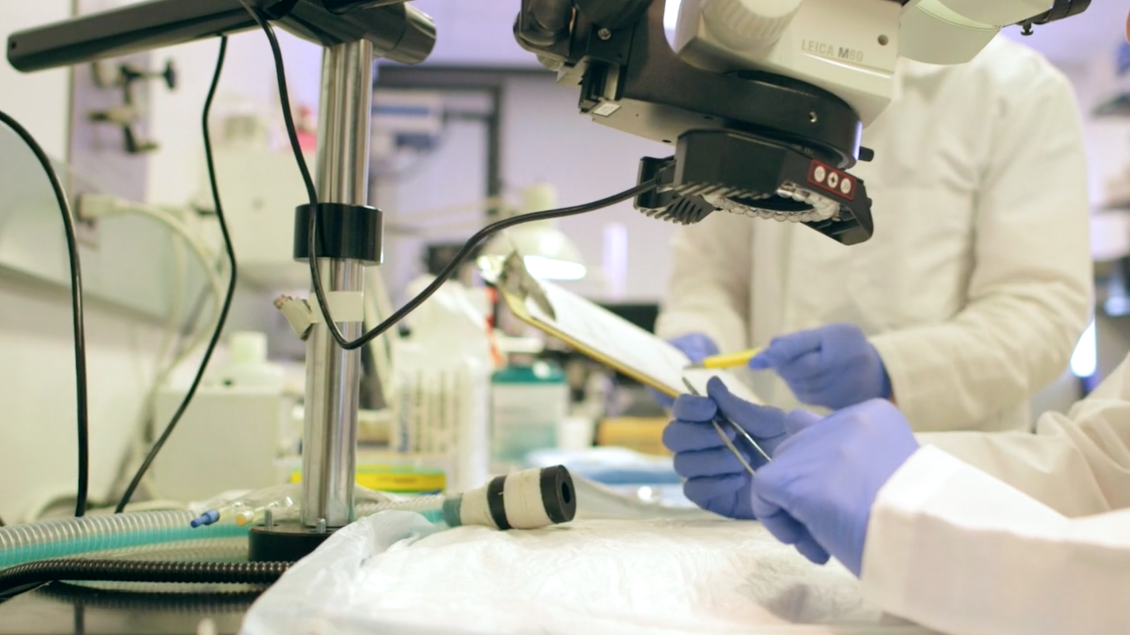
Lab Overview
Learn more about the Craniofacial Research Laboratory's work and impact.
Building upon work that advanced our understanding of bone structure, function, healing and regeneration, we began investigations within the context of radiation. We know that radiation can have destructive effects on bone including, as our lab clarified, through destruction of vasculature and depletion of osteocytes. The damage leads to delayed wound healing and future fractures and can have a tremendous impact on patients' quality of life.
Using small-animal models we have developed, research in our laboratory is identifying the underlying mechanisms as well as pointing us toward new clinical and pharmacotherapeutic approaches to mitigate — and even prevent — much of this damage.
We use a variety of tissue engineering and regenerative medicine strategies to assuage and prevent the effects of radiation on bone and to optimize distraction osteogenesis to promote healing and stimulate bone growth:
- Identification and development of pharmacotherapeutics and devices, including deferoxamine (DFO) and parathyroid hormone (PTH), to promote revascularization and new bone growth at the fracture site
- Drug discovery to proactively protect bone from the harmful effects of radiation, including with DFO, amifostine (AMF) and other compounds, individually and in combination
- Use of stem-cell based approaches, including adipose-derived stem cells, to repair bone
- Expanding our discoveries to new clinical problems, including to healing bones that have not been subject to radiation and to skin and soft tissues to reduce complications in expander-based breast reconstruction in patients treated for breast cancer
- Development of a new, dynamic microscopic video surveillance platform for time-lapse, live-cell imaging to help speed the translational research process.
Early on, our lab elucidated the relationship between mechanical force and the body's ability to stimulate bone growth and investigated additional factors that drive growth and healing. We also demonstrated the underlying tenets of bone healing and how it can be facilitated, even in the context of radiation. We have shown that numerous compounds, including amifostine, deferoxamine, parathyroid hormone and others, as well as stem-cell-based approaches – separately and in combination – can in fact ameliorate and even prevent – the harmful effects of radiation on bone. With deferoxamine and hyaluronic acid, for example, we have been able to improve healing rates from just 20% to over 90% in pre-clinical animal studies.
These discoveries can enable the use of restorative surgical techniques such as distraction osteogenesis (DO), offering new, less invasive and more effective treatment options and hope to patients who have undergone radiation therapy. We are the first to take the concept of radioprotection of bone and apply it to skin and soft tissue in expander-based breast reconstruction for breast cancer patients who have had radiation treatment. The small animal models we have developed of mandibular DO as well as breast reconstruction, femoral fracture for diabetic fracture repair and mandibular fracture for aging are leading to new translational insights into bone and soft tissue regeneration and tissue engineering across a broad range of applications and potential patient populations.
Our lab was among the first to show radiation damage to bone can be prevented. In patients with prior radiation, we've identified compounds and strategies that can ameliorate much of the harm to bone tissue and stimulate regeneration. These results are leading us to identify and develop new therapeutics to improve bone healing and regeneration and enabling the use of DO in patients who have received radiation therapy.
Our work represents the promise of new treatment paradigms for pediatric and adult patients with many types of craniofacial anomalies. For surgeons, our discoveries represent new therapeutic interventions to improve the lives of our patients. In addition, the training in basic and translational research that medical residents gain in our lab is shaping the next generation of surgical scientists to continue developing innovative solutions to difficult clinical problems.
Our laboratory is exceedingly collaborative and includes joint work with faculty across the U-M campus and the country. Examples include research collaborations with the U-M Orthopedic Research Laboratories, the U-M Rogel Cancer Center, Institute of Gerontology, Michigan Diabetes Research Center, Michigan Integrative Musculoskeletal Health Core Resource-Based Center and many others. Nationally, we are part of the Michigan-Pittsburgh-Wyss Resource Center: Supporting Regenerative Medicine in Dental, Oral and Craniofacial Technologies. We are always eager to find new clinical applications of our discoveries.
Research in our lab and through our collaborative efforts is leading us to look at ways to apply our discoveries to bone repair and regeneration in the context of aging and diabetes. We've created small animal models of both. In parallel, we continue to translate our findings to clinical trials to be able to bring them to the operating room and patient bedside.
- NIH National Cancer Institute, R01: Optimization of Bone Regeneration in the Irradiated Mandible
- NIH: Michigan-Pittsburgh-Wyss Resource Center: Supporting Regenerative Medicine in Dental, Oral and Craniofacial Technologies
- NIH: Michigan Integrative Musculoskeletal Health Core Resource-Based Center
- NIH R01: Translational Optimization of Bone Regeneration in the Irradiated Mandible
- NIH T32: Surgical Scientist Training Grant in Health Services and Translational Research
Additional funding organizations that support work in the Craniofacial Research Laboratory include:
- The Plastic Surgery Foundation
- American Society of Maxillofacial Surgeons
- U-M Department of Surgery Surgical Innovation Prize
- U-M Institute of Gerontology
- Michigan Diabetes Research Center
- U-M Rogel Cancer Center
- Michigan Institute for Clinical and Health Research